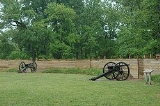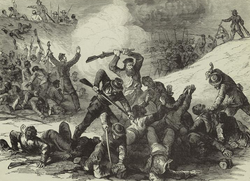
Fort Pillow State Park
Encyclopedia
Fort Pillow State Park is a state park
in western Tennessee
that preserves the American Civil War
site of the Battle of Fort Pillow
. The 1,642 acre
(6.6 km²) Fort Pillow, located in Lauderdale County on the Chickasaw Bluffs overlooking the Mississippi River
, is rich in both historic and archaeological significance.
built extensive fortifications here and named the site for General Gideon J. Pillow of Maury County.
 Because of its strategic location, controlling traffic on the Mississippi River, the fort was attacked and captured by the Union Army
Because of its strategic location, controlling traffic on the Mississippi River, the fort was attacked and captured by the Union Army
, which controlled it during most of the war. An exception to this control occurred for less than one day immediately after the Battle of Fort Pillow
in 1864.
June 4, 1862 – American Civil War: Confederate troops evacuate Fort Pillow on the Mississippi River, leaving the way clear for Union troops to take Memphis, Tennessee.
The Confederate
victory at the Battle of Fort Pillow
(April 1864) ended in the killing of 229 black and white Union
soldier
s out of 262 engaged in the battle
. This slaughter by the Southern
troops under Gen. Nathan Bedford Forrest
has been labeled a massacre; Confederate apologists still debate how much "slaughter" actually took place, and some believe the reports were exaggerated. While the Union casualty count
for the battle does not indicate that the Confederate forces took many prisoners, Confederate records show about 200 prisoners were shipped south. In any case, "Remember Fort Pillow!" became a battle cry
among Black soldiers for the remainder of the Civil War
.
In 1866, the Union Army
created a cemetery for both Confederate and Union soldiers south of the battle site. In 1867, they moved about 250 bodies of Confederate and Union soldiers from that cemetery to the Memphis National Cemetery
.
. It was further declared a National Historic Landmark
in 1974. Remains of the earthworks were well-preserved as of 2011.
The park has an interpretive center and museum (open 8 a.m. – 4 p.m. daily, except for certain holidays). Tours of the museum and restored fortifications are available upon request. The park also offers many recreational activities, including camping, picnicking and fishing.
State park
State parks are parks or other protected areas managed at the federated state level within those nations which use "state" as a political subdivision. State parks are typically established by a state to preserve a location on account of its natural beauty, historic interest, or recreational...
in western Tennessee
Tennessee
Tennessee is a U.S. state located in the Southeastern United States. It has a population of 6,346,105, making it the nation's 17th-largest state by population, and covers , making it the 36th-largest by total land area...
that preserves the American Civil War
American Civil War
The American Civil War was a civil war fought in the United States of America. In response to the election of Abraham Lincoln as President of the United States, 11 southern slave states declared their secession from the United States and formed the Confederate States of America ; the other 25...
site of the Battle of Fort Pillow
Battle of Fort Pillow
The Battle of Fort Pillow, also known as the Fort Pillow Massacre, was fought on April 12, 1864, at Fort Pillow on the Mississippi River in Henning, Tennessee, during the American Civil War. The battle ended with a massacre of surrendered Federal black troops by soldiers under the command of...
. The 1,642 acre
Acre
The acre is a unit of area in a number of different systems, including the imperial and U.S. customary systems. The most commonly used acres today are the international acre and, in the United States, the survey acre. The most common use of the acre is to measure tracts of land.The acre is related...
(6.6 km²) Fort Pillow, located in Lauderdale County on the Chickasaw Bluffs overlooking the Mississippi River
Mississippi River
The Mississippi River is the largest river system in North America. Flowing entirely in the United States, this river rises in western Minnesota and meanders slowly southwards for to the Mississippi River Delta at the Gulf of Mexico. With its many tributaries, the Mississippi's watershed drains...
, is rich in both historic and archaeological significance.
Confederate fort 1861
In 1861, the Confederate States ArmyConfederate States Army
The Confederate States Army was the army of the Confederate States of America while the Confederacy existed during the American Civil War. On February 8, 1861, delegates from the seven Deep South states which had already declared their secession from the United States of America adopted the...
built extensive fortifications here and named the site for General Gideon J. Pillow of Maury County.
Union fort, and Battle of Fort Pillow

Union Army
The Union Army was the land force that fought for the Union during the American Civil War. It was also known as the Federal Army, the U.S. Army, the Northern Army and the National Army...
, which controlled it during most of the war. An exception to this control occurred for less than one day immediately after the Battle of Fort Pillow
Battle of Fort Pillow
The Battle of Fort Pillow, also known as the Fort Pillow Massacre, was fought on April 12, 1864, at Fort Pillow on the Mississippi River in Henning, Tennessee, during the American Civil War. The battle ended with a massacre of surrendered Federal black troops by soldiers under the command of...
in 1864.
June 4, 1862 – American Civil War: Confederate troops evacuate Fort Pillow on the Mississippi River, leaving the way clear for Union troops to take Memphis, Tennessee.
The Confederate
Confederate States of America
The Confederate States of America was a government set up from 1861 to 1865 by 11 Southern slave states of the United States of America that had declared their secession from the U.S...
victory at the Battle of Fort Pillow
Battle of Fort Pillow
The Battle of Fort Pillow, also known as the Fort Pillow Massacre, was fought on April 12, 1864, at Fort Pillow on the Mississippi River in Henning, Tennessee, during the American Civil War. The battle ended with a massacre of surrendered Federal black troops by soldiers under the command of...
(April 1864) ended in the killing of 229 black and white Union
Union Army
The Union Army was the land force that fought for the Union during the American Civil War. It was also known as the Federal Army, the U.S. Army, the Northern Army and the National Army...
soldier
Soldier
A soldier is a member of the land component of national armed forces; whereas a soldier hired for service in a foreign army would be termed a mercenary...
s out of 262 engaged in the battle
Battle
Generally, a battle is a conceptual component in the hierarchy of combat in warfare between two or more armed forces, or combatants. In a battle, each combatant will seek to defeat the others, with defeat determined by the conditions of a military campaign...
. This slaughter by the Southern
Southern United States
The Southern United States—commonly referred to as the American South, Dixie, or simply the South—constitutes a large distinctive area in the southeastern and south-central United States...
troops under Gen. Nathan Bedford Forrest
Nathan Bedford Forrest
Nathan Bedford Forrest was a lieutenant general in the Confederate Army during the American Civil War. He is remembered both as a self-educated, innovative cavalry leader during the war and as a leading southern advocate in the postwar years...
has been labeled a massacre; Confederate apologists still debate how much "slaughter" actually took place, and some believe the reports were exaggerated. While the Union casualty count
Casualty (person)
A casualty is a person who is the victim of an accident, injury, or trauma. The word casualties is most often used by the news media to describe deaths and injuries resulting from wars or disasters...
for the battle does not indicate that the Confederate forces took many prisoners, Confederate records show about 200 prisoners were shipped south. In any case, "Remember Fort Pillow!" became a battle cry
Battle cry
A battle cry is a yell or chant taken up in battle, usually by members of the same military unit.Battle cries are not necessarily articulate, although they often aim to invoke patriotic or religious sentiment....
among Black soldiers for the remainder of the Civil War
American Civil War
The American Civil War was a civil war fought in the United States of America. In response to the election of Abraham Lincoln as President of the United States, 11 southern slave states declared their secession from the United States and formed the Confederate States of America ; the other 25...
.
In 1866, the Union Army
Union Army
The Union Army was the land force that fought for the Union during the American Civil War. It was also known as the Federal Army, the U.S. Army, the Northern Army and the National Army...
created a cemetery for both Confederate and Union soldiers south of the battle site. In 1867, they moved about 250 bodies of Confederate and Union soldiers from that cemetery to the Memphis National Cemetery
Memphis National Cemetery
Memphis National Cemetery is a United States National Cemetery located in the Nutbush neighborhood of the City of Memphis, in Shelby County, Tennessee...
.
Historic site and museum
In 1973, the site was added to the National Register of Historic PlacesNational Register of Historic Places
The National Register of Historic Places is the United States government's official list of districts, sites, buildings, structures, and objects deemed worthy of preservation...
. It was further declared a National Historic Landmark
National Historic Landmark
A National Historic Landmark is a building, site, structure, object, or district, that is officially recognized by the United States government for its historical significance...
in 1974. Remains of the earthworks were well-preserved as of 2011.
The park has an interpretive center and museum (open 8 a.m. – 4 p.m. daily, except for certain holidays). Tours of the museum and restored fortifications are available upon request. The park also offers many recreational activities, including camping, picnicking and fishing.

